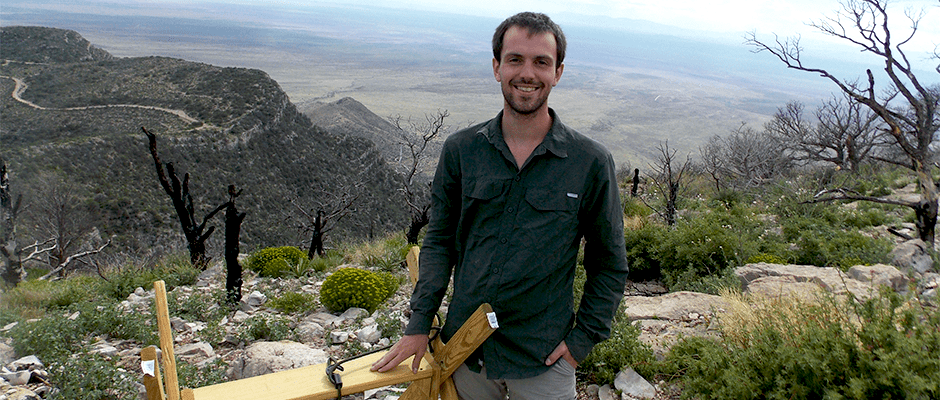Share this article
Student research project: Chipmunks in the Oscura Mountains
In southern New Mexico, a seldom-studied subspecies of chipmunk faces an uncertain future due to the destruction of the high-elevation coniferous woodlands it inhabits. Using camera traps, a recent student research project mapped the distribution of these Oscura Mountains Colorado chipmunks to help inform the population’s monitoring and conservation.
“It was overarching landscape-scale factors like vegetation community type and proximity to steep areas with exposed rock that were most important in predicting what areas were most likely to have chipmunks,” said Ian Perkins-Taylor, who conducted the study for his master’s thesis at New Mexico State University.
Perkins-Taylor started his Oscura Mountains Colorado chipmunk (Neotamias quadrivittatus oscuraensis) research — which earned him second place for his student presentation at the 2017 annual TWS conference in Albuquerque, New Mexico — in 2015. To find out where the animals lived without causing the stress or mortality associated with live trapping, he placed camera traps across the Oscura Mountains, which cover about 10,000 acres in New Mexico’s White Sands Missile Range. He also measured local habitat features, such as ground cover, canopy cover and temperature, and looked at landscape-scale GIS data, including elevation, vegetation productivity and land cover type.
The chipmunks are restricted to mountaintop pinyon woodlands, Perkins-Taylor said, which have been disappearing and fragmenting under pressure from humans, bark beetle outbreaks, droughts, wildfires and climate change over the past decade.
“It’s believed that the pinyon pinecones are the main source of food for the chipmunk, so biologists are worried about how impacts on the pinyon community could affect the chipmunk population,” he said.
The Oscura Mountains Colorado chipmunk is a species of greatest conservation need, according to the New Mexico Department of Game and Fish, which means more research is required to protect it. One of the only published studies on the animals examined their habitat use through visual surveys, Perkins-Taylor said, but walking around searching for chipmunks isn’t as effective as capturing them with camera traps.
Now a biological scientist with the Florida Fish and Wildlife Conservation Commission, Perkins-Taylor became involved with TWS at the regional level when he began his master’s degree. His chipmunk presentation had won the student competition at the joint annual meeting of the New Mexico and Arizona chapters last February, but he wasn’t expecting nationwide recognition.
“That was a big surprise because I didn’t even know they were doing a competition and just got the email,” said Perkins-Taylor, who recently joined the TWS parent society. “We put a lot of work into the presentation to come up with a coherent narrative so we could get across all the background and statistical information while still being interesting. It was nice to hear people thought we did a good job.”
Perkins-Taylor said he enjoyed the “exciting” opportunity to informally share his research, learn from other presentations and network at the TWS conference, which was his first national one.
“It was nice to hear about different research projects around the country, and hearing interesting statistical methods that I may want to try sometime soon,” Perkins-Taylor said. “At that point, I had just been offered the job with the Florida Fish and Wildlife Conservation Commission, so I was able to go to their talk and introduce myself.”
Perkins-Taylor says he’s “definitely” interested in returning to the 2018 annual TWS conference in Cleveland, Ohio, next fall.
Header Image: Ian Perkins-Taylor rests his hand on a camera mount in the Oscura Mountains. ©Haley Smith








